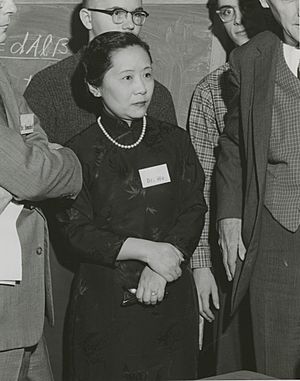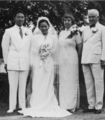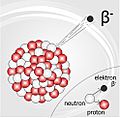Chien-Shiung Wu facts for kids
- This is a Chinese name; the family name is Wu.
Quick facts for kids
Chien-Shiung Wu
|
|
|---|---|

Chien-Shiung Wu in 1958 at Columbia University
|
|
| Born | May 31, 1912 Liuhe, Taicang, Jiangsu, Republic of China
|
| Died | February 16, 1997 (aged 84) New York City, United States
|
| Nationality | American |
| Alma mater | National Central University University of California, Berkeley |
| Known for |
|
| Spouse(s) |
Luke Chia-Liu Yuan
(m. 1942) |
| Children | Vincent Yuan (Chinese: 袁緯承) |
| Awards |
|
| Scientific career | |
| Fields | Physics |
| Institutions | Institute of Physics, Academia Sinica University of California at Berkeley Smith College Princeton University Columbia University Zhejiang University |
| Thesis | I. The Continuous X-Rays Excited by the Beta-Particles of 32P. II. Radioactive Xenons (1940) |
| Doctoral advisor | Ernest Lawrence |
Chien-Shiung Wu (Chinese: 吳健雄; May 31, 1912 – February 16, 1997) was a brilliant Chinese-American nuclear physicist. She was known by many cool nicknames like the "First Lady of Physics" and the "Chinese Madame Curie." She made huge discoveries that changed how we understand the universe.
Contents
Chien-Shiung Wu's Early Life
Chien-Shiung Wu was born in May 1912 in Liuhe, a small town near Shanghai, China. Her father, Wu Zhongyi, was a big supporter of education for girls. This was unusual at a time when many people thought girls didn't need to go to school. He even started an all-girls school!
Wu went to her father's school until she was nine years old. After that, she attended the Soochow Girls’ School. She was a very bright student and graduated in 1930 as the top student in her class.
Her College Years and Studies
After high school, Wu went to Nanjing University to study physics. She graduated in 1934 and then taught at a university for a year.
A year later, she started studying X-ray crystallography in Shanghai. This is a way to study the tiny structures of crystals using X-rays. A woman scientist she worked with told her that the United States had better physics programs. With help from her uncle, Wu sailed to America in 1936 to continue her studies.
Amazing Discoveries in Physics
In the United States, Wu began working on nuclear physics. This field studies the tiny parts inside atoms. She worked with a famous physicist named Ernest Lawrence. She also helped Emilio Segre, who later won a Nobel Prize. While she was busy with her studies, Japan invaded China, and she couldn't contact her family for many years. But she kept working hard.
Wu studied how particles give off energy when they slow down. She also researched what happens when a uranium atom splits. This splitting is called fission. For her important work, she earned her PhD in 1940. She became known as an expert in fission.
She also studied ideas about atoms developed by another famous scientist, Enrico Fermi. Her experiments helped prove one of his theories was correct.
Working on the Manhattan Project
In 1944, during World War II, Wu was asked to join a top-secret project called the Manhattan Project. This project was about creating the first atomic bomb. Wu worked in a secret lab at Columbia University. Her job was to help develop special detectors for radiation.
After the war ended, Wu finally heard from her family. Luckily, they had all survived.
Proving a Big Physics Rule Wrong
One of Chien-Shiung Wu's most famous achievements was helping to prove a major physics rule wrong. This rule was called the "law of conservation of parity." For 30 years, scientists believed that parity was a universal law. It meant that an event and its mirror image would always behave the same way.
Wu, along with two other scientists, Tsung Dao Lee and Chen Wing Yang, showed that this wasn't always true. Wu did most of the difficult experimental work. She found that electrons behaved differently when studied at very low temperatures. Her experiment proved that parity was not always conserved.
Even though Wu did most of the work, the Nobel Prize committee did not give her the award. Instead, her two male partners received the Nobel Prize for this discovery. Many people felt she should have been recognized too.
Her Many Achievements and Honors
Many scientists believed Wu's work on Fermi's theory and her experiment disproving parity were worthy of a Nobel Prize. Even though she didn't get the Nobel Prize, her work had a huge impact on science.
Chien-Shiung Wu was a trailblazer for women in science. She achieved many "firsts":
- She was the first woman to be the president of the American Physical Society.
- She was the first woman to receive the Comstock Award from the National Academy of Sciences.
- She was also the first woman to receive the Research Corporation Award.
- She received honorary degrees from more than a dozen universities, including famous ones like Yale, Princeton, and Harvard.
- Princeton University gave her an honorary doctorate of science. She was the first woman ever to receive this honor from Princeton.
Her Personal Life
Chien-Shiung Wu married Luke Yuan in 1942. She taught at Smith College in Massachusetts, and then at Princeton University.
Wu retired in 1981. She passed away from a stroke on February 16, 1997, in New York, at the age of 86. Her ashes were buried in the courtyard of her father's school in China.
Chien-Shiung Wu was an amazing inspiration. She didn't let challenges like racism or sexism stop her. She worked incredibly hard and made discoveries that greatly advanced our understanding of fission and quantum physics.
Honors, awards, and distinctions
- Elected a fellow of the American Physical Society (1948)
- Elected a member of the U.S. National Academy of Sciences (1958)
- First woman with an honorary doctorate from Princeton University (1958)
- Achievement Award, American Association of University Women (1959)
- John Price Wetherill Medal, The Franklin Institute (1962)
- First female to win the Comstock Prize in Physics, National Academy of Sciences (1964)
- Received an Sc.D. from Yale University (1967)
- Honorary Fellow of the Royal Society of Edinburgh (1969)
- First Pupin Professor in the history of Columbia University (1973)
- Scientist of the Year Award, Industrial Research magazine (1974)
- Honorary degree from Harvard University (1974)
- Tom W. Bonner Prize, American Physical Society (1975)
- First female president of the American Physical Society (1975)
- First female to be honored with the National Medal of Science in Physics (1975)
- First person selected to receive the Wolf Prize in Physics (1978)
- Woman of the Year award from the St. Vincent Culture Foundation under UNESCO (1981)
- Golden Plate Award of the American Academy of Achievement (1984)
- Awarded the Blue Cloud Award for contributions to cultural exchanges between China and America (1985)
- One of 80 distinguished Americans honored with the Ellis Island Medal of Honor (1986)
- Has an asteroid (2752 Wu Chien-Shiung) named after her (1990)
- Pupin Medal, Columbia University (1991)
- Elected one of the first foreign academicians of the Chinese Academy of Sciences (1994)
- Inducted into the National Women's Hall of Fame (1998)
- A college at Southeast University was named in her honor (2003)
- A street at CERN was named Route Wu (2004)
- A 23-foot bronze statue of Wu was unveiled at the Suzhou Chien-shiung Institute of Technology (2012)
- Her portrait was added into New York City Hall (2020)
- Time magazine named her the "Woman of the Year" for 1945 (2020)
- The United States Postal Service issued a Forever stamp featuring her portrait (2021)
Images for kids
-
Wu's father Wu Zhong-Yi was a member of the group of rebels during the revolution that ended China's last dynasty and started the new republic. This period of dramatic social change influenced the feminist views of Wu and her father.
-
Wu (right) in an outing with Margaret Lewis in Berkeley, California
-
Chien-Shiung Wu and Luke Yuan (left) at the home of Mr. and Mrs. Robert Millikan (right) on their wedding day
-
Mao Zedong and Chiang Kai-shek would fight for the fate of the country immediately after the united Chinese forces won the second world war.
-
The experiments of Columbia University physicists (left to right) Wu, Y.K. Lee, and L.W. Mo confirmed the theory of conservation of vector current. In the experiments, which took several months to complete, proton beams from Columbia's Van de Graaff accelerator were transmitted through pipes to strike a 2 mm boron target at the entrance to a spectrometer chamber.
See also
 In Spanish: Chien-Shiung Wu para niños
In Spanish: Chien-Shiung Wu para niños















